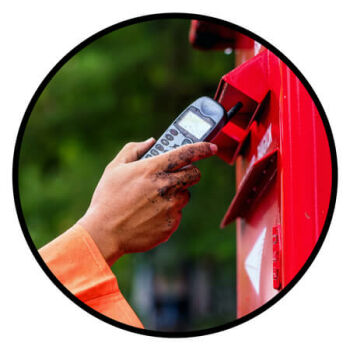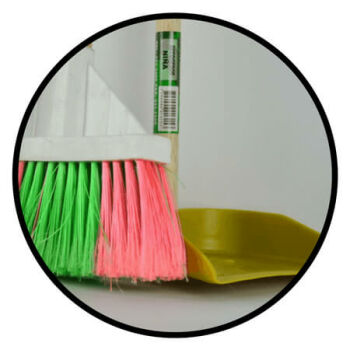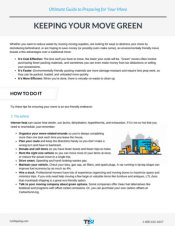Whether you want to reduce waste by reusing moving supplies, are looking for ways to destress your move by decluttering beforehand, or are hoping to save money (or possibly even make some), eco-friendly moving boasts a few advantages over a traditional move:
- It’s Cost Effective: The less stuff you have to move, the lower your costs will be. “Green” moving often involves purchasing less packing materials, and sometimes you can even make money from tax deductions or selling your possessions. Get more tips for keeping your moving costs low in our budgeting guide.
- It’s Faster: Environmentally friendly packing materials are more damage resistant and require less prep work, so they can be packed, loaded, and unloaded more quickly, leaving you more time to get ready for moving day and settle in after you unpack.
- It’s More Efficient: When you’re done, there is virtually no waste to clean up.
Understanding the advantages of eco-friendly moving is all well and good, but you might be asking yourself what exactly you can do to make your move green. Try these tips for ensuring your move is an environmentally-friendly endeavor:
1. Choose the right vehicle for the job
A local move uses approximately 1.4 gallons of gas and produces 28lbs of CO2 emissions. Planning ahead allows you to minimize all move-related trips, which helps you conserve gas, spend less time on the road, and ultimately reduce your CO2 emissions, which only increase the farther you move:
|
Distance |
CO2 Emissions |
Gallons of Gas |
|
|
Local Move |
Less than 10 miles |
28 lbs |
1.40 |
|
Regional Move |
Less than 50 miles |
140 lbs |
7.10 |
|
Cross-Country Move |
Greater than 50 miles |
8,400 lbs |
428.60 |
A little waste is unavoidable here. You have to move, which means you will require some kind of transportation to relocate your belongings, but there are several ways to cut down on the number of trips and limit your emissions:
- Organize your move-related errands so you're always completing more than one task each time you leave the house.
- Plan your route and keep the directions handy so you don’t make a wrong turn and have to backtrack.
- Donate and sell items so you have fewer boxes and fewer trips to make.
- Maintain your vehicle. If it’s been awhile since your last tune up, check your tires, gas cap, air filters, and spark plugs. A car running in tip-top shape can improve fuel economy by as much as 4%. If your car does break down, find out what to do in our guide to managing unexpected moving problems.
- Rent the right size vehicle so you can move more of your items at once, or even reduce the actual move to a single trip.
- Drive smart. Speeding and harsh braking wastes gas, so drive carefully.
- Talk to your moving company about green options. Some companies offer clean fuel alternatives like biodiesel and programs with offset carbon emissions. Or, you can purchase your own carbon offsets at Carbonfund.org.
- Hire a truck. Professional movers have lots of experience organizing and moving boxes to maximize space and minimize trips. If you only need help moving a few valuable or large items like furniture and antiques, LTL (less than truckload) shipping is a great eco-friendly option.
What is LTL shipping?When you ship some of your belongings via LTL freight, they will share truck space with other cargo heading in the same direction, which helps reduce your carbon footprint and your moving bill. Learn more about LTL shipping. |
2. Downsize your belongings

Downsizing before you move helps you cut down on clutter and get a fresh start in your new home. It also helps to lower the overall expense of your move. Not sure how to declutter? Here are some common tactics:
Reduce
Selling is by far the best way to get rid of your stuff because you can lighten your load and earn a little cash as well. Selling or giving your items directly to friends and family also ensures that your items are going to be put to good use. Aside from the traditional yard sale, there are a few ways to unload your items:
- Craigslist, Amazon, or eBay: Include lots of photos as well as a detailed description of the product and its condition.
- Consignment stores.
- If it’s valuable and in good condition, consider an auction.
Approximately 80% of donated clothing ends up in a landfill eventually, and furniture accounts for 9.8 million tons of landfill waste. If you do decide to donate, make sure your belongings are in good enough condition to sell and reuse, and give them to a reputable charity, such as:
- Goodwill
- Habitat for Humanity
- The Salvation Army
- The National Furniture Bank Association
- Other local registered charities of your choice
If you are downsizing your files and other paperwork, make sure you hold on to any important documents you might need for your move.
Reuse
Another good practice to get in the habit of is repurposing and using up your old items. Before you drop off that box of stuff at a donation center, take some time and think about whether or not your items could be used for something else:
- Cut up clothing can become cleaning rags or homemade handkerchiefs.
- Boxes and containers of any material can be used for storage.
- Packaging can be used to create small containers that help organize almost any space you can think of.
- Repurpose old furniture by getting creative and turn it into something you love - there are lots of DIYs for upcycling your old stuff on Pinterest!
Recycle

Once you have donated, sold, or found a second use for every item possible, it’s time to recycle what’s left over. What you can put in your recycle bins is highly dependent on where you live, so start by checking your local municipality’s website for more information. Regardless of where you reside, there are some items that will require a special trip:
- Hazardous Materials - This includes items like batteries, fertilizer, ammunition, paint thinners, and other chemicals. Many moving companies will not ship these items for you because of the potential threat they pose to the environment, movers, and your belongings. To get rid of these items safely, keep an eye out for special collection events in your area, check Earth911, or call 1-800-CLEANUP to find a recovery location near you that accepts them.
- Electronics - Make sure you wipe any personal information and take your electronics to a place where they will be properly recycled. Both Best Buy and Staples have electronics recycling programs, or you can use Recycle Nation to find an electronics recycling location near your home.
Learn more about recycling on the EPA website.
3. Get packing
It may seem impossible to get everything you own packed away without spending money or generating waste, but there are a lot of creative ways to pack your belongings without resorting to non-recyclables:
- Use containers you already have, such as:
- Suitcases
- Plastic storage bins
- Old cardboard boxes - old boxes are ideal for light items, but should not be used for anything heavy or fragile in case the seams burst.
- Reusable shopping bags
- Rent plastic boxes that can be returned and reused when you’re done.
- Purchase recycled moving supplies.
- Opt for alternatives to packing peanuts and bubble wrap:
- Green, biodegradable packing peanuts
- Shredded paper
- Blankets
- Newspaper
- Towels
- Sheets
- Stuffed animals
- Clothing - as long as you don’t mind it getting wrinkled!
To ensure their safety in transit, fragile and valuable items should always be packed with proper packing materials. Order recycled, eco-friendly boxes and supplies here.

4. Clean up
Whether you’re prepping your old place for the new tenants or tidying up your new home before you move in, using green cleaning supplies is another great way to keep your move environmentally-friendly from start to finish. Try these tips:
- Avoid harsh chemicals by sticking to the basics - vinegar, lemon juice, and baking soda go a long way when it comes to cleaning.
- Try eco-friendly brands like bioKleen, Bon Ami, and Dr. Bronner’s.
- Choose reusable cleaning tools like mops, brooms, and towels over one-time-use products.
Stay Green
Moving is an opportunity to start fresh and learn new habits! Take a few steps to maintain this positive attitude and stay green after you move: use LED light bulbs, remember to turn off and unplug lights and appliances when not in use, switch to biodegradable products, cut down on unnecessary packaging, and consider future purchases carefully. Mindful consumption and other environmentally-conscious practices mean less effort sorting, selling, donating, and recycling your belongings the next time you move.
Download our Printable GuideClick to download (PDF)
Download the complete printable Ultimate Guide to Preparing for Your Move. |
Keep Reading the Ultimate Guide to Preparing for Your MovePart 1: Budgeting for Your Move Part 7: Moving Large, Heavy, or Bulky Items |

